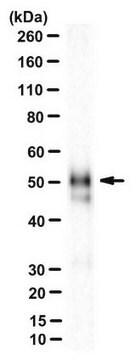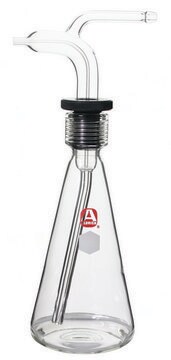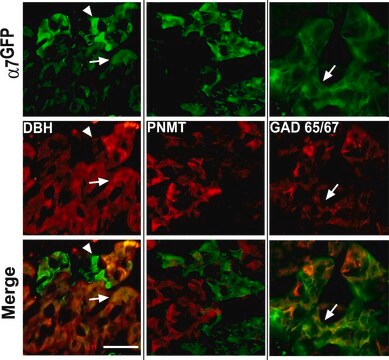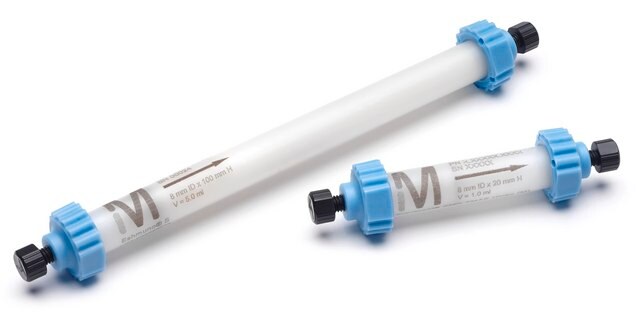MSP3L
MS PhosphoMix 3 Light
Phosphopeptide Standard for MS
Synonym(s):
Light PhosphoMix, MS Phosphorylation Mix, PhosphoMix 3 Light
Sign Into View Organizational & Contract Pricing
All Photos(1)
About This Item
UNSPSC Code:
12352200
NACRES:
NA.24
Recommended Products
quality
Phosphopeptide Standard for MS
Quality Level
analyte chemical class(es)
amino acids, peptides, proteins
packaging
pkg of 200 pmol total phosphopeptides
technique(s)
HPLC: suitable
LC/MS: suitable
application(s)
food and beverages
format
multi-component solution
storage temp.
−20°C
General description
The MS PhosphoMix line of products allows for the testing of the strengths and weaknesses of phosphopeptide sample processing, mass spectrometry analysis and instrument configurations. The mixes are produced from synthetic phosphopeptides with sequences derived from naturally occurring peptides as identified by Mann et al. in HeLa cells. Because the sequences are derived from mammalian cells, many natural phosphorylation motifs, such as those that present an abundance of proline, are represented. Additionally, the phosphopeptide distribution in each mix has been chosen to present a broad range of characteristics, including ionizability, LC retention time, charge state, and isoelectric point. Finally, PhosphoMix-1, 2, and 3 were designed in a complementary fashion, as highlighted on the following page. For example, all three mixes contain peptides of the same sequence with different sites of phosphorylation.
Each of the three phosphopeptides mixes are available in their naturally occurring isotopic abundances (light) or as stable isotope enriched versions (heavy), making the set of products highly amenable to quantitative analyses, allowing users to compare recovery between workflows or techniques.
More info and FASTA file
Each of the three phosphopeptides mixes are available in their naturally occurring isotopic abundances (light) or as stable isotope enriched versions (heavy), making the set of products highly amenable to quantitative analyses, allowing users to compare recovery between workflows or techniques.
- Naturally occurring peptide sequences
- Broad range of peptide characteristics
- Complementary product designs
- Available in light and heavy versions
More info and FASTA file
related product
Product No.
Description
Pricing
Storage Class Code
10 - Combustible liquids
WGK
WGK 3
Flash Point(F)
Not applicable
Flash Point(C)
Not applicable
Choose from one of the most recent versions:
Certificates of Analysis (COA)
Lot/Batch Number
Don't see the Right Version?
If you require a particular version, you can look up a specific certificate by the Lot or Batch number.
Already Own This Product?
Find documentation for the products that you have recently purchased in the Document Library.
Jordy J Hsiao et al.
Analytical chemistry, 90(15), 9457-9464 (2018-07-07)
Phosphorylated compounds and organic acids with multiple carboxylate groups are commonly observed to have poor peak shapes and signal in LC/MS experiments. The poor peak shape is caused by the presence of trace metals, particularly iron, contributed from a variety
Dorte B Bekker-Jensen et al.
Nature communications, 11(1), 787-787 (2020-02-09)
Quantitative phosphoproteomics has transformed investigations of cell signaling, but it remains challenging to scale the technology for high-throughput analyses. Here we report a rapid and reproducible approach to analyze hundreds of phosphoproteomes using data-independent acquisition (DIA) with an accurate site
Evgeny Kanshin et al.
Journal of proteome research, 12(6), 2905-2913 (2013-04-24)
Phosphorylation is a reversible protein modification that regulates major cellular processes such as cell division, growth, and differentiation through highly dynamic and complex signaling pathways. Large-scale phosphoproteomics analyses have been greatly facilitated using affinity chromatography such as metal oxide affinity
Daniel Schwartz et al.
Nature biotechnology, 23(11), 1391-1398 (2005-11-08)
With the recent exponential increase in protein phosphorylation sites identified by mass spectrometry, a unique opportunity has arisen to understand the motifs surrounding such sites. Here we present an algorithm designed to extract motifs from large data sets of naturally
Alexander R Ivanov et al.
Proteomics, 13(6), 904-909 (2013-01-16)
Proteomics is a rapidly transforming interdisciplinary field of research that embraces a diverse set of analytical approaches to tackle problems in fundamental and applied biology. This viewpoint article highlights the benefits of interlaboratory studies and standardization initiatives to enable investigators
Our team of scientists has experience in all areas of research including Life Science, Material Science, Chemical Synthesis, Chromatography, Analytical and many others.
Contact Technical Service







